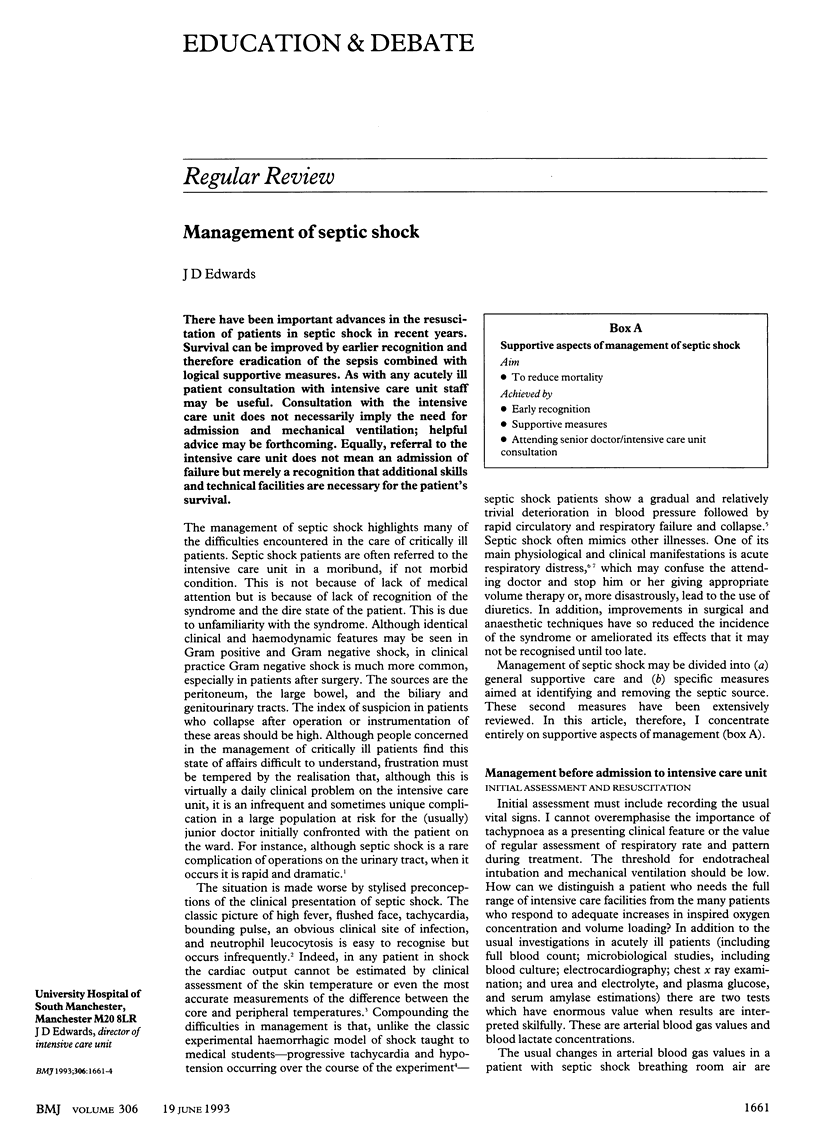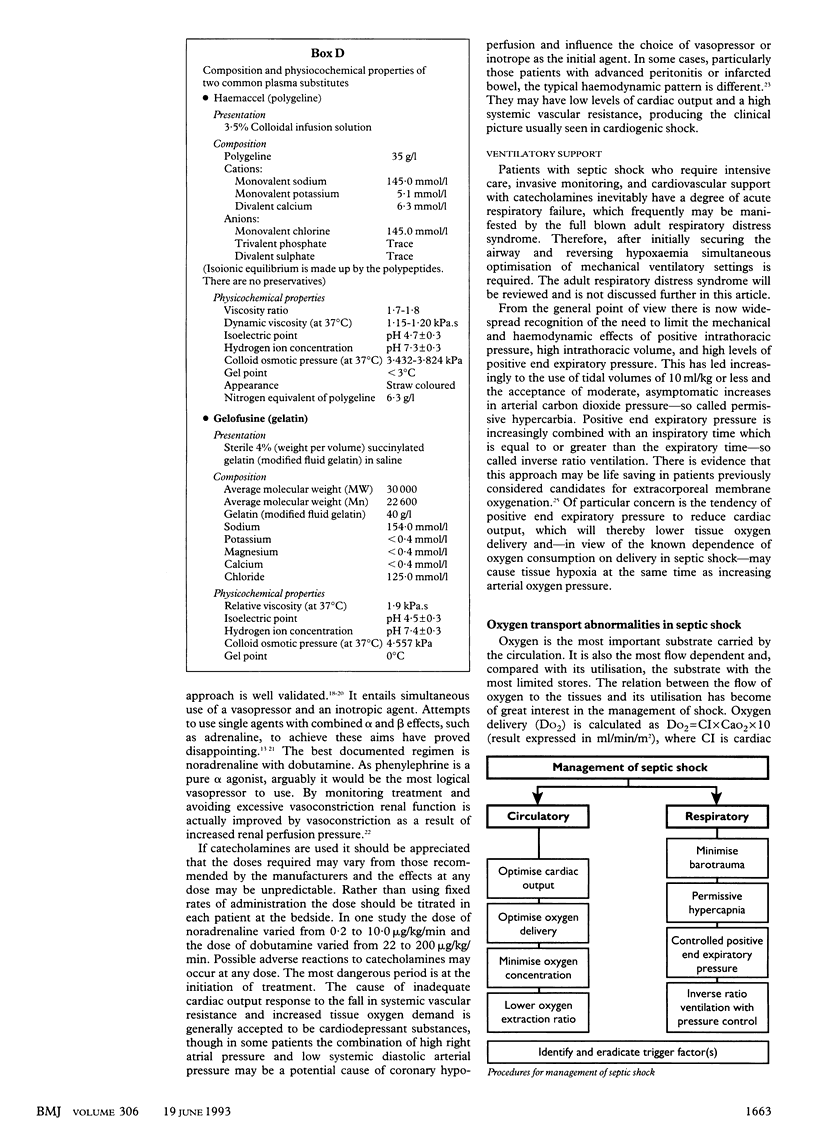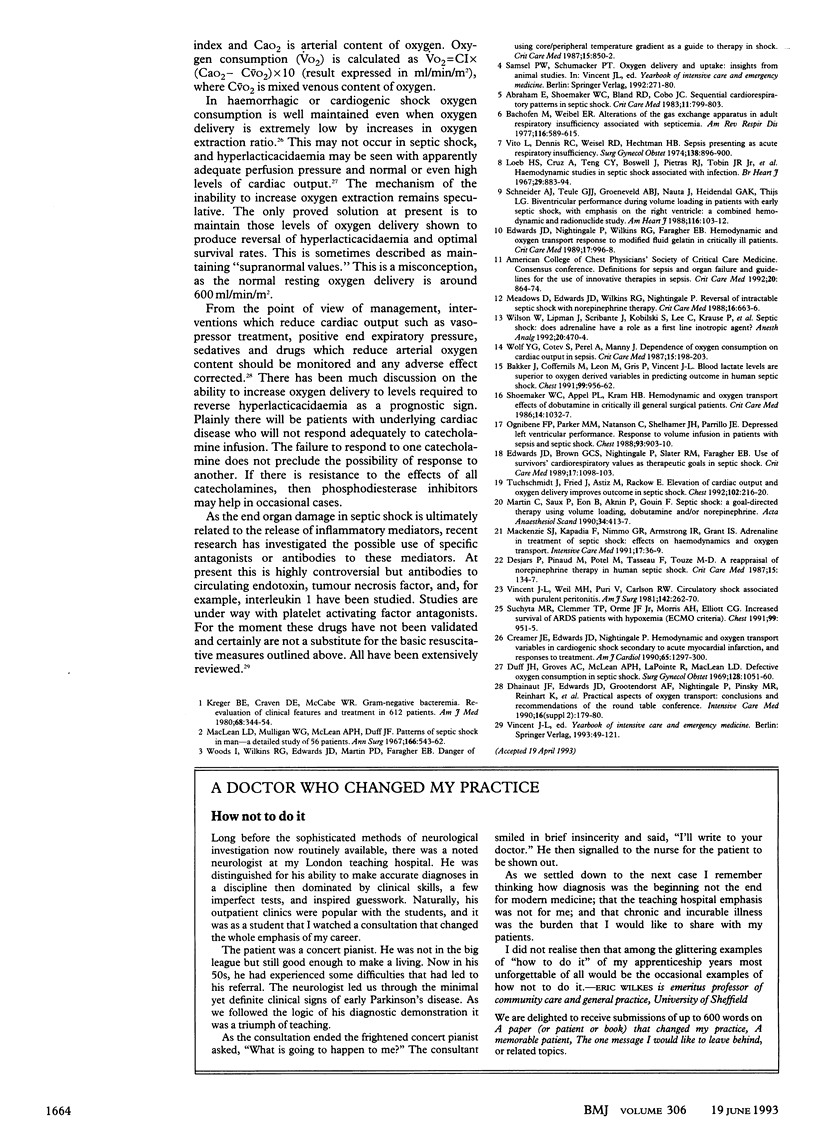Abstract
There have been important advances in the resuscitation of patients in septic shock in recent years. Survival can be improved by earlier recognition and therefore eradication of the sepsis combined with logical supportive measures. As with any acutely ill patient consultation with intensive care unit staff may be useful. Consultation with the intensive care unit does not necessarily imply the need for admission and mechanical ventilation; helpful advice may be forthcoming. Equally, referral to the intensive care unit does not mean an admission of failure but merely a recognition that additional skills and technical facilities are necessary for the patient's survival.
Full text
PDF



Selected References
These references are in PubMed. This may not be the complete list of references from this article.
- Abraham E., Shoemaker W. C., Bland R. D., Cobo J. C. Sequential cardiorespiratory patterns in septic shock. Crit Care Med. 1983 Oct;11(10):799–803. doi: 10.1097/00003246-198310000-00007. [DOI] [PubMed] [Google Scholar]
- Bachofen M., Weibel E. R. Alterations of the gas exchange apparatus in adult respiratory insufficiency associated with septicemia. Am Rev Respir Dis. 1977 Oct;116(4):589–615. doi: 10.1164/arrd.1977.116.4.589. [DOI] [PubMed] [Google Scholar]
- Bakker J., Coffernils M., Leon M., Gris P., Vincent J. L. Blood lactate levels are superior to oxygen-derived variables in predicting outcome in human septic shock. Chest. 1991 Apr;99(4):956–962. doi: 10.1378/chest.99.4.956. [DOI] [PubMed] [Google Scholar]
- Creamer J. E., Edwards J. D., Nightingale P. Hemodynamic and oxygen transport variables in cardiogenic shock secondary to acute myocardial infarction, and response to treatment. Am J Cardiol. 1990 Jun 1;65(20):1297–1300. doi: 10.1016/0002-9149(90)91316-x. [DOI] [PubMed] [Google Scholar]
- Desjars P., Pinaud M., Potel G., Tasseau F., Touze M. D. A reappraisal of norepinephrine therapy in human septic shock. Crit Care Med. 1987 Feb;15(2):134–137. doi: 10.1097/00003246-198702000-00011. [DOI] [PubMed] [Google Scholar]
- Duff J. H., Groves A. C., McLean A. P., LaPointe R., MacLean L. D. Defective oxygen consumption in septic shock. Surg Gynecol Obstet. 1969 May;128(5):1051–1060. [PubMed] [Google Scholar]
- Edwards J. D., Brown G. C., Nightingale P., Slater R. M., Faragher E. B. Use of survivors' cardiorespiratory values as therapeutic goals in septic shock. Crit Care Med. 1989 Nov;17(11):1098–1103. doi: 10.1097/00003246-198911000-00002. [DOI] [PubMed] [Google Scholar]
- Edwards J. D., Nightingale P., Wilkins R. G., Faragher E. B. Hemodynamic and oxygen transport response to modified fluid gelatin in critically ill patients. Crit Care Med. 1989 Oct;17(10):996–998. doi: 10.1097/00003246-198910000-00006. [DOI] [PubMed] [Google Scholar]
- Kreger B. E., Craven D. E., McCabe W. R. Gram-negative bacteremia. IV. Re-evaluation of clinical features and treatment in 612 patients. Am J Med. 1980 Mar;68(3):344–355. doi: 10.1016/0002-9343(80)90102-3. [DOI] [PubMed] [Google Scholar]
- Loeb H. S., Cruz A., Teng C. Y., Boswell J., Pietras R. J., Tobin J. R., Jr, Gunnar R. M. Haemodynamic studies in shock associated with infection. Br Heart J. 1967 Nov;29(6):883–894. doi: 10.1136/hrt.29.6.883. [DOI] [PMC free article] [PubMed] [Google Scholar]
- MacLean L. D., Mulligan W. G., McLean A. P., Duff J. H. Patterns of septic shock in man--a detailed study of 56 patients. Ann Surg. 1967 Oct;166(4):543–562. doi: 10.1097/00000658-196710000-00004. [DOI] [PMC free article] [PubMed] [Google Scholar]
- Mackenzie S. J., Kapadia F., Nimmo G. R., Armstrong I. R., Grant I. S. Adrenaline in treatment of septic shock: effects on haemodynamics and oxygen transport. Intensive Care Med. 1991;17(1):36–39. doi: 10.1007/BF01708407. [DOI] [PubMed] [Google Scholar]
- Martin C., Saux P., Eon B., Aknin P., Gouin F. Septic shock: a goal-directed therapy using volume loading, dobutamine and/or norepinephrine. Acta Anaesthesiol Scand. 1990 Jul;34(5):413–417. doi: 10.1111/j.1399-6576.1990.tb03114.x. [DOI] [PubMed] [Google Scholar]
- Meadows D., Edwards J. D., Wilkins R. G., Nightingale P. Reversal of intractable septic shock with norepinephrine therapy. Crit Care Med. 1988 Jul;16(7):663–666. doi: 10.1097/00003246-198807000-00003. [DOI] [PubMed] [Google Scholar]
- Ognibene F. P., Parker M. M., Natanson C., Shelhamer J. H., Parrillo J. E. Depressed left ventricular performance. Response to volume infusion in patients with sepsis and septic shock. Chest. 1988 May;93(5):903–910. doi: 10.1378/chest.93.5.903. [DOI] [PubMed] [Google Scholar]
- Schneider A. J., Teule G. J., Groeneveld A. B., Nauta J., Heidendal G. A., Thijs L. G. Biventricular performance during volume loading in patients with early septic shock, with emphasis on the right ventricle: a combined hemodynamic and radionuclide study. Am Heart J. 1988 Jul;116(1 Pt 1):103–112. doi: 10.1016/0002-8703(88)90256-6. [DOI] [PubMed] [Google Scholar]
- Shoemaker W. C., Appel P. L., Kram H. B. Hemodynamic and oxygen transport effects of dobutamine in critically ill general surgical patients. Crit Care Med. 1986 Dec;14(12):1032–1037. doi: 10.1097/00003246-198612000-00008. [DOI] [PubMed] [Google Scholar]
- Suchyta M. R., Clemmer T. P., Orme J. F., Jr, Morris A. H., Elliott C. G. Increased survival of ARDS patients with severe hypoxemia (ECMO criteria). Chest. 1991 Apr;99(4):951–955. doi: 10.1378/chest.99.4.951. [DOI] [PubMed] [Google Scholar]
- Tuchschmidt J., Fried J., Astiz M., Rackow E. Elevation of cardiac output and oxygen delivery improves outcome in septic shock. Chest. 1992 Jul;102(1):216–220. doi: 10.1378/chest.102.1.216. [DOI] [PubMed] [Google Scholar]
- Vito L., Dennis R. C., Weisel R. D., Hechtman H. B. Sepsis presenting as acute respiratory insufficiency. Surg Gynecol Obstet. 1974 Jun;138(6):896–900. [PubMed] [Google Scholar]
- Wilson W., Lipman J., Scribante J., Kobilski S., Lee C., Krause P., Cooper J., Barr J. Septic shock: does adrenaline have a role as a first-line inotropic agent? Anaesth Intensive Care. 1992 Nov;20(4):470–474. doi: 10.1177/0310057X9202000413. [DOI] [PubMed] [Google Scholar]
- Wolf Y. G., Cotev S., Perel A., Manny J. Dependence of oxygen consumption on cardiac output in sepsis. Crit Care Med. 1987 Mar;15(3):198–203. doi: 10.1097/00003246-198703000-00003. [DOI] [PubMed] [Google Scholar]
- Woods I., Wilkins R. G., Edwards J. D., Martin P. D., Faragher E. B. Danger of using core/peripheral temperature gradient as a guide to therapy in shock. Crit Care Med. 1987 Sep;15(9):850–852. doi: 10.1097/00003246-198709000-00010. [DOI] [PubMed] [Google Scholar]


